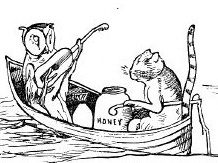The Owl and the Pussy-Cat
| The Owl and the Pussy-Cat | |
|---|---|
| by Edward Lear | |
 Edward Lear's illustration of the Owl and the Pussycat | |
| Illustrator | Edward Lear |
| Country | United Kingdom |
| Publication date | 1871 |
| Full text | |
"The Owl and the Pussy-cat" is a nonsense poem by Edward Lear, first published in 1870 in the American magazine Our Young Folks[1] and again the following year in Lear's own book Nonsense Songs, Stories, Botany, and Alphabets. Lear wrote the poem for a three-year-old girl, Janet Symonds, the daughter of Lear's friend and fellow poet John Addington Symonds and his wife Catherine Symonds. The term "runcible", used for the phrase "runcible spoon", was invented for the poem.
Synopsis[edit]
"The Owl and the Pussy-cat" features four anthropomorphic animals – an owl, a cat, a pig, and a turkey – and tells the story of the love between the title characters who marry in the land "where the Bong-tree grows".
Unfinished sequel[edit]
Portions of an unfinished sequel, "The Children of the Owl and the Pussy-cat" were published first posthumously, during 1938. The children are part fowl and part cat, and love to eat mice.
The family live by places with strange names. The Cat dies, falling from a tall tree, leaving the Owl a single parent. The death causes the Owl great sadness. The money is all spent, but the Owl still sings to the original guitar.[2]
Derivative works[edit]
British picture book author Beatrix Potter has stated that her work The Tale of Little Pig Robinson is the back story of the character Piggy from The Owl and the Pussycat.[3] It was adapted into a film of the same name in 1970.
Media[edit]

- Beatrix Potter wrote a prequel, The Tale of Little Pig Robinson, telling the background story of the pig character.
- The text has been set to music many times, such as by:
- Victor Hely-Hutchinson, whose 1927 setting was recorded by Elton Hayes in 1953 for Parlophone.[4]
- Humphrey Searle in 1951, using twelve-tone technique for the accompanying flute, guitar, and cello, but sprechgesang for the vocal part[5]
- Igor Stravinsky composed his setting in October 1966.
- It was the main topic of The Owl and the Pussycat Went to See..., a 1968 children's musical play about Lear's nonsense poems. The play was written by Sheila Ruskin and David Wood.[6]
- In 1996, Eric Idle published a children's novel, The Quite Remarkable Adventures of the Owl and the Pussycat, based on the poem. Idle's narration of the audiobook was nominated for the 1998 Grammy Award for Best Spoken Word Album for Children.
- In 1998, Naxos Records produced album "Seven Ages: An Anthology of Poetry with Music" which contains a recording of John Cleese reading The Owl and the Pussycat on track 15.[7]
- American avant-garde artist and composer Laurie Anderson's 5th album, Bright Red (1994) features the track "Beautiful Pea Green Boat", which incorporates lyrics from the poem.
- Adapted as "Henrietta Pussycat" and "Owl X" in the PBS show Mr. Rogers Neighborhood starting from Episode 0001 (1968) to Episode 1761 (2001) where the two characters lived in a treehouse within the Land of Make Believe
See also[edit]
References[edit]
- ^ Lucy Larcom, ed. (February 1870). "The Owl and the Pussy-Cat". Our Young Folks. VI (II): 111–112. Retrieved 5 August 2022.
- ^ Lear, Edward. "The Children of the Owl and the Pussy-cat". nonsenselit.org.
- ^ Beatrix, Potter (15 November 2017). "The Tale of Little Pig Robinson".
- ^ "Details of the 45 rpm record of Elton Hayes' recordings of Edward Lear songs". 45cat.com/. Retrieved 7 October 2011.
- ^ Stevens, Denis (1970). A History of Song. Vol. The Norton Library 536. New York: W. W. Norton & Company. p. 179. ISBN 0393005364..
- ^ "The Owl and the Pussycat Went to See..." davidwood.org.uk. Retrieved 8 February 2011.
- ^ "SEVEN AGES - An Anthology of Poetry with Music - NA218912". www.naxos.com. Retrieved 23 March 2020.
External links[edit]
 The Owl and the Pussycat public domain audiobook at LibriVox
The Owl and the Pussycat public domain audiobook at LibriVox- The Owl and the Pussy-cat in many languages (archive from 1 August 2015; accessed 10 July 2019)
- Reely's Poetry Pages – audio of The Owl and The Pussycat (Anthology of English Verse, vol. 1)
- "Pea Green Boat" by comedian Stewart Lee
- The Owl and the Pussycat by Storynory
- "The Owl & the Pussycat" recited by Dawn Miceli from The Dawn and Drew Show
- Tales of Curiosity short video, text and images of The Owl and the Pussy-cat
- Setting of poem as a song by Ronald Corp performed by Mark Stone and Simon Lepper
- "The Owl & the Pussycat" by Elton Hayes
